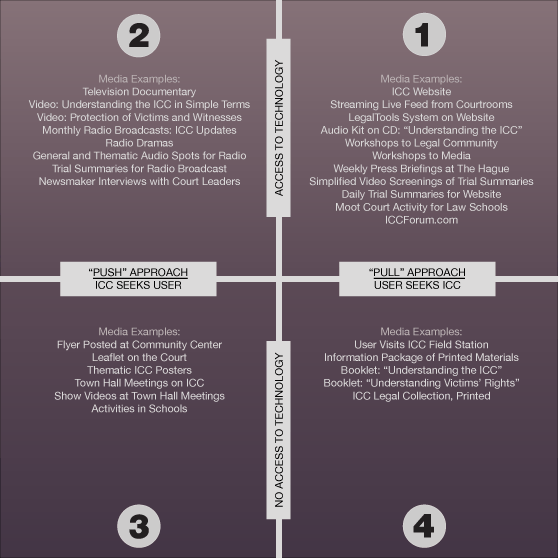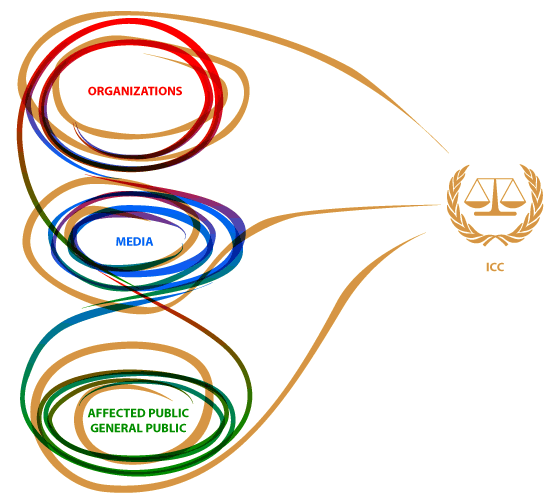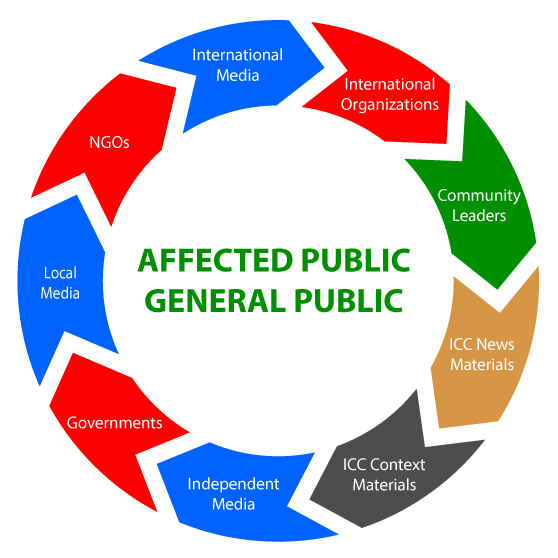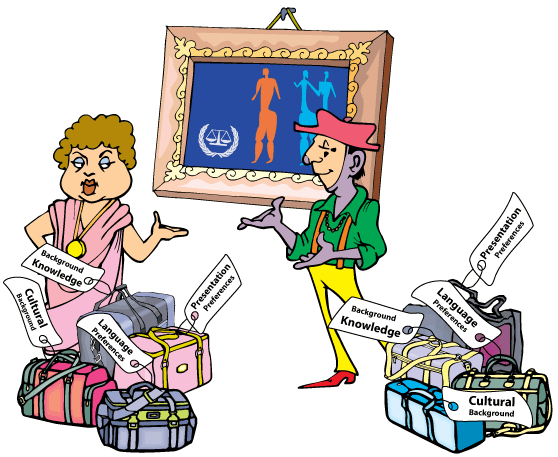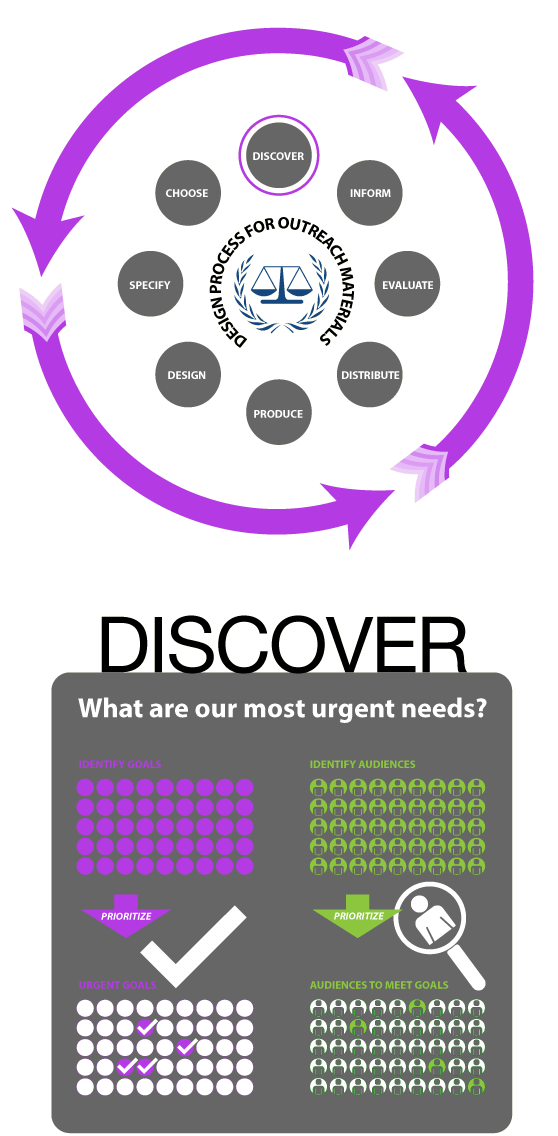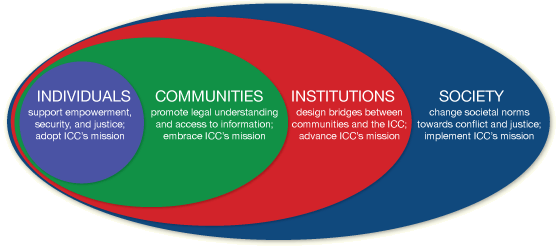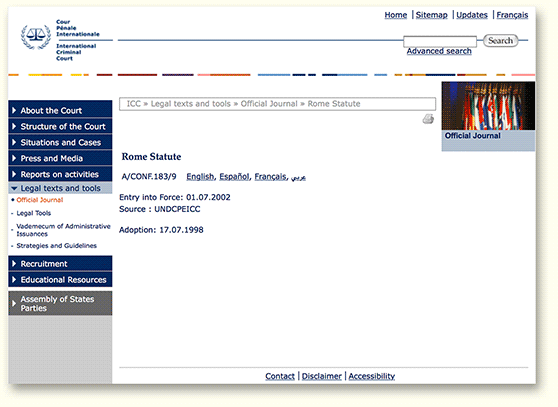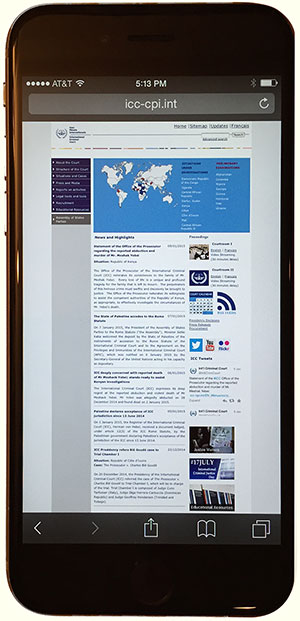States Must Support the ICC’s Use of New Technology for Outreach
The ICC’s implementation of outreach could benefit from developments in new forms of technology. In order to assess the use of such new tools in designing effective outreach strategies, the ICC must first conduct mapping exercises to determine the level of access and technology infrastructure within a given community.
Summary
Outreach is a critical component of the work of the ICC. Claims to the contrary can be countered through an assessment of the mandate and purpose of international justice. Although the ICC has adopted a comprehensive definition of outreach, there are still aspects relating to the broader objectives of meaningful engagement which must be included in the Court’s approach. Additionally, the ICC’s implementation of outreach could benefit from developments in new forms of technology. In order to assess the use of such new tools in designing effective outreach strategies, the ICC must first conduct mapping exercises to determine the level of access and technology infrastructure within a given community. Addressing any security threats, including through new technology, is crucial to this initial assessment phase. In terms of technology tools which facilitate communication, the ICC has several options for building partnerships with technology partners, including on the provision of hardware and tools which facilitate connectivity. Finally, in terms of the substance of the engagement, the ICC can also maximize partnerships with actors currently generating content on the work of the Court. However, technology tools cannot replace the need for developing culturally sensitive and gender appropriate methodologies, and securing the funding from the Member States in order to ensure the ICC is co-developing strong outreach and public information strategies with the affected communities.
Argument
The premise that international courts ought to conduct outreach is disputed.1 Critics of the ICC, along with proponents of tight budgeting, have argued that the court should stick to its core activities: the running of in-court trials.2 Such claims are often supported by the view that international justice mechanisms are not charged with establishing the historical record of the events beyond the prosecution of those deemed most responsible, and thus there is no role for courts other than establishing the guilt of those senior leaders. Likewise, critics point to the limited role courts should have in reconciliation processes, which is a sensitive political process beyond the scope of a court’s legal expertise.3 Within this line of thinking, public information and outreach is perceived to be a mere public relations exercise which is inappropriate for a judicial entity which must concentrate its efforts on assessing facts and applying the law. Indeed, these criticisms may appear to have been borne out historically, since both the Ad Hoc Tribunals for Rwanda and the Former Yugoslavia did not include public information as part of the official budget and instead outreach was funded by a small group of States on a voluntary basis.4
Assessments of past tribunals have demonstrated that without outreach, international justice takes place in a decontextualized vacuum which risks rendering the entire legal process pointless.
However, there are several ways in which the very foundations of international justice require robust outreach and public information processes. Firstly, assessments of past tribunals have demonstrated that without outreach, international justice takes place in a decontextualized vacuum which risks rendering the entire legal process pointless. An in-depth population-based survey of the communities in Rwanda demonstrated that the work of the Rwanda Tribunal was virtually unknown to the majority of the population in Rwanda.5 This limited the impact of the Tribunal’s work to those immediately involved in the cases litigated at the Tribunal (although the impact for witnesses was not always positive), and thereby created a general view that international justice was an expensive waste of time. A similar population-based survey was conducted in the Balkans, and found that the judgments of the Tribunal were exacerbating existing tensions, since each side viewed the Tribunal’s judgments as either vindicating or denying their experience of the conflict. The conclusion of this study identified that outreach was crucial in providing information about the cases and understanding about the justice processes, including how cases were selected and how judges determined guilt through convictions or acquittals. Such information provided citizens the opportunity to situate the legal process within the broader community healing process and reconciliation.
Although deterrence theory is a new area of analysis under international criminal law, it’s application within the context of the ICC is dependent on public information regarding the work of the Court.
This social science research is particularly helpful in identifying the importance of outreach in achieving several aspects of the ICC’s mandate, as set out in the Preamble to the Rome Statute. First, the Preamble to the Rome Statute links accountability with peace and security,6 which thereby recognizes the broader context within which the Court operates, and thus the need for the Court to interact with actors outside the court. This places an obligation on the Court to engage with the full range of constituents responsible for maintaining peace and security, including directly to citizens through outreach and public information. Secondly, the Preamble highlights the objective of the international community to prevent crime through the work of the ICC.7 Research relating to penal theory, particularly with respect to deterrence, emphasizes the importance of knowledge of the law as a key variable within the factors that lead to a deterrent effect.8 Although deterrence theory is a new area of analysis under international criminal law, it’s application within the context of the ICC is dependent on public information regarding the work of the Court.9 Finally, most of the core activities set out within the Rome Statue depend to a large extent on voluntary cooperation with outside actors. This is particularly the case for the ICC which, unlike the previous Ad Hoc Tribunals, includes components of the civil law system through the victim participation process.10 In order to ensure the Court receives due assistance from intermediaries11 or obtains cooperation from potential victim participants or witnesses, the Court must actualize its obligation of ensuring fully informed consent through providing appropriate public information and conducting outreach to ensure that the greatest number of possible actors have access to the Court. This increased knowledge of the Court and its methods of operation will have a positive impact on the ability for outside actors to interact with the Court and thereby enhance the ability of the Court to achieve its mandate. In other words, outreach is not only required within the terms of the Court’s objectives, but conducting outreach is also in the Court’s own best interests.
After establishing that the ICC is required to conduct outreach and public information, it is then necessary to determine what activities constitutes outreach, and in turn, what challenges exist to the implementation of outreach. Outreach does not have a strict technical definition and its meaning is not set out in the core legal documents of the Court. However, the ICC has publicized its own definitions through its public website and its official reports, including most recently in the Report of the Court on the Public Information Strategy 2011–2013.12 These definitions cover key components within civil society definitions, in particular the 2011 Outreach Report of the International Center for Transitional Justice (“ICTJ”).13 The ICC states that public information is the provision of accurate and timely information about to Court “to the public at large as well as to specific audiences, through a variety of means.”14 Outreach is defined by the ICC as a “sustainable, two-way communication” with communities affected by the situations that are within the area of the Court’s legal proceedings. The ICC specifically notes that outreach, aside from an engagement with outside communities, also seeks to “clarify misperceptions and misunderstandings and to enable affected communities to follow trials.”15
These definitions from the ICC are impressively comprehensive, including recognition for the need to ensure a dialogue as opposed to a one-directional approach to communication with information simply transmitted from the court. However, it is notable that definition adopted by the ICTJ places greater emphasis on building “direct channels of communication with affected communities”16 in order to ensure the Court is responsive to the unique challenges faced within each content. According to the ICTJ, outreach and public information programs should ensure that accountability processes are:
meaningful to the affected population, while providing the knowledge and tools necessary for the people to actively participate in the process. […] outreach programs should be to promote public engagement and ownership of the justice process, thereby contributing to building its legitimacy and lasting impact.17
Understood in this way, the ICC outreach work would therefore also need to extend beyond the trials in The Hague, but also should extend to assisting with the Court’s positive complementarity work, and additionally, ought to address questions regarding the legacy of the Court. Both these issues (positive complementarity and legacy) are yet to be addressed in a clear strategy by the Court and the Member States.
There are several emerging new tools, particularly those utilizing technology, which can assist the Court in overcoming challenges to outreach and facilitate the Court in achieving its mandate.
Within the parameters of these definitional issues, many concrete challenges can be identified. There are several emerging new tools, particularly those utilizing technology, which can assist the Court in overcoming challenges to outreach and facilitate the Court in achieving its mandate.
The most crucial challenge which ought to be addressed from the outset in any context is the question of security and protection. The ICC provides protection in only a limited range of circumstances, generally when individuals are put at risk as a result of their activities with the Court.18 However, in certain situations, even holding information about the Court (such as through attending outreach sessions or obtaining public information documents from the Court) can put a person at risk from targeted retaliation attacks by entities opposed to the Court’s operations. By conducting a thorough risk assessment in preparing a communications strategy in advance of entering a new situation, ICC staff can ascertain the means by which the Court can engage with people within a given country, and thereby identify the security risks associated with the means of communication and the means of engagement primarily utilized in that country.
There are several groups which provide security expertise and training, and keep abreast of technology developments and the new emerging challenges. For example, Security First covers protection issues responding to the full spectrum of threats faced by human rights defenders, from physical risks through to threats to confidentiality.19 Security First is currently compiling an interactive app called “Umbrella” which will allow a human rights defender to choose what they want to do, such as: conduct risk assessment; securely make a call/email; securely access the internet; encrypt data; plan secure travel; protect their office/home; plan counter-surveillance; measure insider threats; use a safe-house; or deal with kidnapping, arrest or evacuation.20 Tactical Tech21 also provides training materials on security and protection such as Security-in-a-Box,22 and Mobiles-in-a-Box for cell phone security.23 Another NGO called Mobile Active24 provides similar support through their SafeMobile project. Also for cell phones, Amnesty International has devised a tool called the “Panic Button” which will alert an emergency contact should the button be activated on the device in the case of a threat.25 The ICC could collaborate with such experts in security and protection in order to devise robust communication strategies that are safety-orientated.
The extent to which technology is utilized within a given ICC situation country is critical in devising an outreach and public information strategy which will maximize the opportunity for a meaningful engagement. Technology is often critical to the establishment of contact and enabling dialogue. International courts and tribunals typically rely upon intermediary organizations such as survivor networks and local human rights groups in order to initiate communication and conduct outreach. However, in order to best design innovative and meaningful outreach strategies, the ICC must build strategies which are reflective of the technology infrastructure within a given country and region. This requires the ICC to conduct a mapping of the technology infrastructure and use. There are several organizations which are active in mapping global communication infrastructure, for example, the Engine Room is developing a project called TechScape to provide empirical data on technology use.26 The World Bank27 and internet services providers also typically conduct reviews of market access.
Depending on the access to mobile technology, the ICC could utilize tools which target either Smartphone platforms or non-Smartphone platforms.
For example, access to cell phones is increasing rapidly, with access growing at 366% in East Africa in the last five years and 260% in Central Africa.28 However the Court must be sure to assess each country individually, since access varies dramatically per country—for example, 85% of the population in Cote d’Ivoire have access to cell phones whereas 17% have access in the Central African Republic.29 Access is also dominated by gender and other societal dynamics, with women overall 23% less likely than men to own a mobile phone within the Africa region.30 Depending on the access to mobile technology, the ICC could utilize tools which target either Smartphone platforms or non-Smartphone platforms. For example, Frontline SMS utilizes SMS text messages to connect phones around content-sharing and interacting through group messages and receiving feedback.31 This tool is open source and can be customized according to the requirements of the context. Another group, People’s Intelligence, utilizes a similar interactive SMS-text phone format to collect information regarding human rights abuses.32 For Smartphone users, there are additional sources which could be of assistance in developing engagement platforms with the ICC, such as Obscuracam developed by WITNESS and The Guardian Project, which allows people to record video whilst pixilating the faces of respondents who wish to remain anonymous.33 Several key computer research centers have capacity to address communication challenges and the ICC could engaged with institutions such as Carnegie Mellon University to identify potential technology solutions to outreach and public information challenges.34 Over 2015, the Open Society Justice Initiative will be working with partners to coalesce these emerging tools into a set of guidelines to assist NGOs in interacting with the ICC. Although the focus will be around the collection of potential information for the cases, the means of interaction will also be of potential use for public information and outreach activities.
In instances of limited technology infrastructure, there are several hardware based developments which the ICC could consider in order to facilitate access to its constituency.
In instances of limited technology infrastructure, there are several hardware based developments which the ICC could consider in order to facilitate access to its constituency. For example, the Nairobi-based technology center i-Hub35 has fostered innovate solutions to its technology needs, including a device known as “BRCK” (pronounced “brick”) which enables internet access without electricity.36 It is a Wi-Fi router and mobile modem in one, which can be connected to the internet by Ethernet and will also switch to a 3G or 4G connection if the power cuts out. It can support up to 20 wireless connections and can work as a network drive through its 16 gigabytes of storage. Another group working in hardware development, Videre, specializes in developing technology which incorporates security mechanisms and enables encrypted, covert communication.37 Aside from advancing communication methods, the ICC may also consider radio hardware options in settings where information is disseminated largely through broadcasting channels. For example, Partners in Technology International installs high frequency radio systems, radio email, and satellite phones in remote areas,38 and Telecoms Sans Frontier conducts similar work to increase connections with information dissemination.39
Finally, there a technology-based tools which can assist the ICC in addressing the challenge of content creation. The ICC already does fantastic work emailing weekly updates and YouTube clips of in-court sessions.40 Several web-based partners also conduct daily in-court monitoring designed to assist journalist and lawyers access specialized knowledge on ICC developments, such as ijmonitor.org,41 ICC Forum,42 and justicehub from Radio Netherlands Worldwide.43 However, the ICC website could provide greater access to filings such as the searchable databases developed by the SCSL,44 ECCC,45 ICTR46 and ICTY.47 There are several technology groups specializing in the development of such databases such as Benetech,48 Huridocs,49 and the Human Rights Data Analysis Group.50
Perhaps the biggest challenge facing the outreach and public information program is designing communication strategies jointly with communities, and yet finding means to ensure balanced representation of voices. The ICC must strive to ensure their communications are gender-balanced, culturally sensitive, and empowering for voices which may typically denied space within their own community. This challenge has faced cross-cultural disciplines for decades, the social sciences have developed complicated participatory modes and the ICC could learn a lot from more creative means of creating dialogue.51 Unfortunately, there is no snazzy technology fix for designing such sensitive processes. And even more unfortunately, all components set out in this discussion depend entirely upon the financing provided by the Member States.
Endnotes — (click the footnote reference number, or ↩ symbol, to return to location in text).
-
1.
, Lessons for Outreach from the Ad Hoc Tribunals, The Special Court for Sierra Leone, and the International Criminal Court, 14 New Eng. J. Int’l & Comp. L. 299 (Dec. 3, 2008), available online, archived. ↩
- 2.
-
3.
, Justice and Peace: The Role of International Tribunals in International Justice, E-Int’l Rel. (Jan. 24, 2012), available online. ↩
-
4.
Support and Donations, International Criminal Tribunal for the Former Yugoslavia, available online (last visited Feb. 12, 2015). ↩
-
5.
& , My Neighbor, My Enemy: Justice and Community in the Aftermath of Mass Atrocity (Cambridge University Press 2004). ↩
-
6.
Rome Statute of the International Criminal Court, Adopted by the United Nations Diplomatic Conference of Plenipotentiaries on the Establishment of an International Criminal Court, Jul. 17 1998, UN Doc. A/CONF.183/9 [hereinafter Rome Statute]. ↩
- 7.
-
8.
Discussion of Recent Deterrence Studies, Death Penalty Information Center, available online (last visited Feb. 12, 2015). ↩
-
9.
, The International Criminal Court and Deterrence: The ‘Lubanga Syndrome’, Justice in Conflict (Apr. 6, 2012), available online. ↩
-
10.
, Taking Stock of the Impact of the Rome Statute and the International Criminal Court on Victims and Affected Communities, Int’l Crim. Ct., available online (last visited Feb. 12, 2015). ↩
-
11.
Intermediaries and the International Criminal Court: A Role for the Assembly of States Parties, Coalition for the International Criminal Court, Open Society Justice Initiative, available online (last visited Feb. 12, 2015). ↩
-
12.
Report of the Court on the public information strategy 2011–2013, ICC-ASP/9/29 (Nov. 22, 2010) at 6, available online [hereinafter Strategy 2011–2013]. ↩
-
13.
, ICTJ, Making an Impact: Guidelines on Designing and Implementing Outreach Programs for Transitional Justice (Jan. 2011) available online. ↩
-
14.
Outreach, Int’l Crim. Ct., available online, archived (last visited Feb. 12, 2015). ↩
- 15.
- 16.
- 17.
-
18.
, Witness Protection Measures at the International Criminal Court: Legal Framework and Emerging Practice, 23 Crim. L. Forum 97 (2012) available online. ↩
-
19.
Security First, available online (last visited Feb. 12, 2015). ↩
-
20.
Umbrella, Security First, available online (last visited Feb. 12, 2015). ↩
-
21.
About Us, Tactical Technology Collective, available online (last visited Fed. 12, 2015). ↩
-
22.
Security In-A-Box, Tactical Technology Collective, available online (last visited Feb. 12, 2015). ↩
-
23.
Mobiles In-A-Box, Tactical Technology Collective, available online (last visited Feb. 12, 2015). ↩
-
24.
Mobile Active Defense, available online (last visited Feb. 12, 2015). ↩
-
25.
Amnesty International Launches New App to Fight Attack, Kidnap and Torture, Amnesty Int’l (Jun. 23, 2014), available online. ↩
-
26.
TechScape, The Engine Room, available online (last visited Feb. 12, 2015). ↩
-
27.
Internet Users (per 100 people), The World Bank, available online (last visited Feb. 16, 2015). ↩
-
28.
et al., GSMA, Sub-Saharan Africa Mobile Observatory 2012 (2012), available online. ↩
- 29.
-
30.
Women & Mobile: A Global Opportunity, GSMA (2013) available online. ↩
- 31.
-
32.
People’s Intelligence, available online (last visited Feb. 12, 2015). ↩
-
33.
Obscuracam: Secure Smart Camera, The Guardian Project, available online (last visited Feb. 12, 2015). ↩
-
34.
Center for Human Rights Science, Carnegie Mellon University, available online (last visited Feb. 13, 2015). ↩
- 35.
- 36.
- 37.
-
38.
Partners in Technology, available online (last visited Feb. 12, 2015). ↩
-
39.
Télécoms Sans Frontières, available online (last visited Feb. 12, 2015). ↩
-
40.
International Criminal Court, YouTube, available online (last visited Feb. 16, 2015). ↩
-
41.
International Justice Monitor, available online (last visited Feb. 12, 2015). ↩
- 42.
-
43.
Radio Netherlands Worldwide, available online (last visited Feb. 12, 2015). ↩
-
44.
The Residual Special Court for Sierra Leone, available online (last visited Feb. 12, 2015). ↩
-
45.
Extraordinary Chambers in the Courts Of Cambodia, available online (last visited Feb. 12, 2015). ↩
-
46.
International Criminal Tribunal for Rwanda, available online (last visited Feb. 12, 2015). ↩
-
47.
International Criminal Tribunal for the Former Yugoslavia, available online (last visited Feb. 12, 2015). ↩
- 48.
- 49.
-
50.
Human Rights Data Analysis Group, available online (last visited Feb. 12, 2015). ↩
-
51.
Participatory Rural Assessment, Village Volunteers (Jul. 9, 2011) available online. ↩
-
Suggested Citation for this Comment:
, States Must Support the ICC’s Use of New Technology for Outreach, ICC Forum (Feb. 17, 2015), available at https://iccforum.com/outreach#Cole.
Suggested Citation for this Issue Generally:
How can the ICC Improve its Outreach Efforts?, ICC Forum (Feb. 17, 2015), available at https://iccforum.com/outreach.


